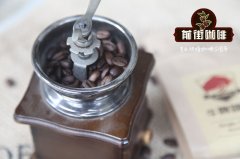Recommendation of SHG Coffee beans in pola Bora producing area of Nicaragua

Professional coffee knowledge exchange more coffee bean information please follow the coffee workshop (Wechat official account cafe_style)
Nicaraguan "Paula" is a traditional name, which reflects the folklore and strength of Nicaraguan women. It refers to coffee cultivated in the northern regions of Segovia, Matagalpa and Jinotega. The temperature in this area is 20 Murray 29 degrees Celsius and the average annual rainfall is 1500--1700mm, making it the best condition for coffee production. Nicaraguan "Paula" is not widely known in China, but its sour taste, clean taste and charming aroma have long been recognized as boutique coffee among coffee lovers in Europe.
Nicaraguan coffee has a wide variety of flavors. Some of the Nicaraguan coffee is reminiscent of Mexican coffee, and some of it is reminiscent of the smell of Guatemala. But what they have in common is that compared with the rich aroma of Nicaraguan coffee, Nicaraguan coffee on the market has been neglected. Some coffee experts highly value that the aroma of Nicaraguan coffee is more textured and uniform than that of coffee in the alpine regions of Central and South America. Generally speaking, high-quality Nicaraguan coffee prides itself on its classical aroma. Recently, there has been a strong trend to use brands from coffee producing areas in various regions for marketing. In the boutique coffee market, Nicaraguan coffee is characterized by nutty and vanilla aromas, complex and soft taste, and appropriate texture.
Coffee was introduced to Nicaragua by Catholic missionaries in 1790 and was originally grown for the purpose of curiosity. It was not until about 1840 that coffee cultivation began to receive attention due to the growth of global demand for coffee. The first commercial planting area in the country is around Managua.
The coffee industry had a great impact on the economy from 1840 to 1940, commonly known as the "coffee boom" in Nicaragua (Coffee Boom). With the increase of the importance and value of coffee, the industry also needs more resources and manpower. In 1870, coffee became a major export crop in Nicaragua, and the government was committed to making it easy for foreign companies to invest in the industry and acquire land. In the past, state-owned land was sold to private individuals, and the government encouraged the establishment of large estates through subsidies passed in 1879 and 1889, with more than 5000 coffee plantations subsidized by the government for each additional tree.
By the end of the 19th century, Nicaragua became a politically called "banana republic", with most of the revenue from coffee going abroad or into the pockets of local landlords.
The first coffee cooperative in the territory was established in the early 20th century, which was the policy of the Somoza family dictatorship from 1936 to 1979. However, the rule of the Somocha family was later overthrown by the Sanding National Liberation Front. After 1979, the coffee industry entered a difficult period, when the US-backed anti-government was committed to overthrowing the new government, and part of its political manifesto was directed against the coffee industry, attacking the vehicles transporting coffee workers and destroying coffee processing plants.
Nevertheless, by 1992, coffee was still the most important cash crop for export to Nicaragua. However, coffee prices fell sharply between 1999 and 2003, which dealt a severe blow to the coffee industry. Three of the country's six largest banks have been dragged down because of their close ties to the coffee industry. Low prices, coupled with devastating Hurricane Mitch in 1998 and the drought in 2000, once again hit the coffee industry.
Fortunately, the coffee industry in Nicaragua is picking up, and coffee agriculture is beginning to focus on improving quality. In the past, Nicaraguan coffee production and marketing resumes were not easy to obtain and were mostly sold under the name of processing plants or specific producing areas, and such production and marketing resumes were implemented quite thoroughly.
Production and marketing resume
Coffee can be traced back to a single estate or a common cooperative made up of producers.
Coffee taste
Nicaraguan coffee tastes quite diverse. Most of them are very complex with pleasant fruity aromas and pure acidity.
Producing area
Population: 6071000
2013 output: 1500000 bags
There are several small producing areas in Nicaragua, including Madiz,Managua,Boaca and Carazo, which, although not listed below, produce excellent coffee.
END
Important Notice :
前街咖啡 FrontStreet Coffee has moved to new addredd:
FrontStreet Coffee Address: 315,Donghua East Road,GuangZhou
Tel:020 38364473
- Prev

Suggestion on making Black Honey Coffee at Bosnian Manor in Nicaragua. Is brownie delicious with Black Honey?
Professional coffee knowledge exchange more coffee bean information Please pay attention to the coffee workshop (Wechat official account cafe_style) Honey treatment and peeling sun treatment will have a fuller Body, generally speaking, the more pectin from coffee cherries when coffee beans are dried, the more mellow Body can be tasted in coffee. Black honey coffee beans are usually famous for their honey syrup-like sweetness, such as
- Next

Advice on tanning Angel Coffee at Maria Manor in Nicaragua _ introduction to Maria Manor
Professional coffee knowledge exchange more coffee bean information please follow the coffee workshop (Wechat official account cafe_style) Nicaraguan Coffee-Maria Manor Black Angel Coffee beans introduction Nicaragua Las Marias applicable: single product / single product concentrated refined method: sun products: Kaddura, bourbon altitude: 1300 meters flavor: floral, apricot, melon roaster tips let
Related
- Detailed explanation of Jadeite planting Land in Panamanian Jadeite Manor introduction to the grading system of Jadeite competitive bidding, Red bid, Green bid and Rose Summer
- Story of Coffee planting in Brenka region of Costa Rica Stonehenge Manor anaerobic heavy honey treatment of flavor mouth
- What's on the barrel of Blue Mountain Coffee beans?
- Can American coffee also pull flowers? How to use hot American style to pull out a good-looking pattern?
- Can you make a cold extract with coffee beans? What is the right proportion for cold-extracted coffee formula?
- Indonesian PWN Gold Mandrine Coffee Origin Features Flavor How to Chong? Mandolin coffee is American.
- A brief introduction to the flavor characteristics of Brazilian yellow bourbon coffee beans
- What is the effect of different water quality on the flavor of cold-extracted coffee? What kind of water is best for brewing coffee?
- Why do you think of Rose Summer whenever you mention Panamanian coffee?
- Introduction to the characteristics of authentic blue mountain coffee bean producing areas? What is the CIB Coffee Authority in Jamaica?

